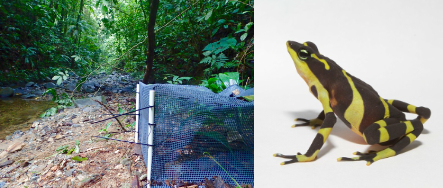The Panama Amphibian Rescue and Conservation Project completed the first reintroduction trial of the Limosa Harlequin frog (Atelopus limosus) in 2017, and our findings were published in the journal Frontiers in Amphibian and Reptile Science. Reintroducing a species comes with a lot of unknowns and questions, just a few are: Where will the frogs go? What is their life like outside of a terrarium? Will they become infected with amphibian chytrid fungus? The purpose of this first reintroduction trial was to begin to unravel some of these questions so the researchers could adapt their strategies and improve the odds of the frogs in the wild.
We were able to get a detailed life of the frogs post-reintroduction by radiotracking the frogs and checking in on them daily. We found that when frogs were provided a 30-day acclimation period in a predator-free rainforest mesocosm, their probability of survival significantly increased and they did not disperse as far as the hard-released animals. We know from other studies that more movement can increase the likelihood of predators finding animals, and that likely happened in this study too. Frogs that were released without radio transmitters were 44x less likely to be reencountered during stream surveys (finding a frog in the rainforest isn’t easy!). We were able to follow the lives of these frogs in the wild for up to 56 days after release and developed a method that can use both radio-tracked animals and non-radiotracked animal encounters to estimate survivorship by assigning different detection probabilities in the model.
We observed a couple predation events of reintroduced frogs and some became infected with amphibian chytrid fungus. However, we learned a lot and has no shortage of questions to continue researching to get this species (and others in Panama) back into the wild.
Read the open access paper here:
Klocke, B., Estrada, A., Mataya, M., Medina, D., Baitchman, E., Belden, L., Guerrel, J., Evans, M., Baughman, J. and Connette, G., Illueca, E., Ibáñez, R., Gratwicke, B. (2023) Movement and survival of captive-bred Limosa Harlequin frog (Atelopus limosus) released into the wild. Frontiers in Amphibian and Reptile Science, 1, p.1205938. https://doi.org/10.3389/famrs.2023.1205938
by Blake Klocke

